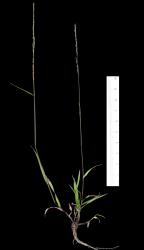- Taxon
- Gallery
Plants weak, 25–50 cm. Leaf-sheath membranous, strongly ribbed, pubescent, especially the light brown basal sheaths. Ligule 1–3 mm, erose, abaxially pubescent. Leaf-blade 6–10 cm × 1.5–2 mm, scabrid on ribs or smooth, adaxially sometimes shortly and sparsely pubescent; margins minutely scabrid. Culm internodes glabrous. Panicle 10–15 cm, ± pyramidal; rachis glabrous, branches ± scabrid, binate, spreading to reflexed, naked in lower ½, pedicels short, pubescent, ± appressed to branchlets. Spikelets 2.5–3 mm, 1-flowered, lanceolate, light green. Glumes glabrous, ovate-lanceolate to ovate, acute, margins ciliate; lower 0.5–0.7 mm, upper 0.8–1 mm. Lemma ≈ spikelet, shortly pubescent, 3-nerved or with 2 additional fainter lateral nerves, ovate-lanceolate, acute to mucronate. Palea 2–2.5 mm, 1–2-nerved, shortly pubescent, especially on nerves. Rachilla prolongation c. 0.5 mm, very minutely ciliate. Anthers c. 1 mm. Caryopsis c. 1.5 mm long. 2n= 28.
[From: Edgar and Connor (2000) Flora of New Zealand. Volume 5 (second printing).]




